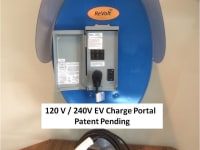Energy for transportation vehicles is undergoing a transformation from gas to electricity - why and how does this happen? The primary drivers for 'why' are:
1) Corporate Average Fuel Economy (CAFE) regulations require 40+ mpg with gas vehicles @ 25 mpg, hybrid vehicles @ 50 mpg and electric vehicles (EVs) @ 100+ empg.
2) Gas costs $0.10 /mile and electricity costs $0.04/mile.
3) EVs are simple, clean, quiet and fun (fast).
EV charging portals are rated at three power levels:
1) 120 volt AC /2 kW charging @ 4 miles of range /hour for hybrid vehicles with less than 50 miles of electric range in 10 hours or less.
2) 240 volt AC/10 kW charging @ 30 miles of range /hour for EVs up to 300 miles of range in 10 hours or less.
3) 400 volt DC /120 kw charging @ 300 miles of range /hour for EVs up to 300 miles of range in 1 hour or less for highway trips.
The primary 'how' architecture to build a cost effective electric vehicle charging infrastructure is 'destination charging' portals at both 120 V and 240 V power levels. This transformation will drive a 50% decrease in the gas station energy distribution model (currently 100,000 gas stations) and a 1000% growth of EV charge portals (currently 10,000 portals) as the new electrical energy distribution model (not including home charging ports).
EVs (including hybrid electric vehicles) are sold with a mobile charging cable having a 120 or 240 volt plugs on one end to be plugged into a corresponding outlet and a custom coupler on the other end to plug into the electric vehicle for the purpose of charging. Current charging 'stations' are designed to provide the custom charging coupler to the vehicle but do not have the portability of the mobile charging cable and hence multiply the costs for EV charging apparatus for different locations (travel destinations e.g. home, workplace, hotels, malls, airports, etc ).
This invention provides a universal standard solution as a charging portal for both 120 and 240 volt outlets that provide the AC power source for all mobile charging cables (thus all hybrids and EVs) in all locations for a minimum investment for charging apparatus with 5X lower cost than the charging 'station' model. The invention further provides environmental (weather) protection and security protection for the portal user via solar camera and motion lighting. The access to the outlets is safety protected with circuit breakers to be turned off during the process of plugging into or out of the outlets. The technology to implement this architecture is based on proven standards and production processes for electrical hardware. The savings of the portal model vs. the station model will enable acceleration of the EV charging infrastructure at minimal investments. The 'station model' for electrical distribution is best applied to the high power (120 kW) DC charging model for highway travels delivering 90% charge in one hour.
Like this entry?
-
About the Entrant
- Name:Myron Trenne
- Type of entry:individual
- Software used for this entry:PowerPoint
- Patent status:pending





